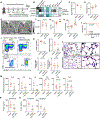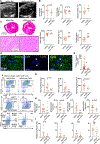Virus-Induced Acute Respiratory Distress Syndrome Causes Cardiomyopathy Through Eliciting Inflammatory Responses in the Heart
- PMID: 38506045
- PMCID: PMC11216864
- DOI: 10.1161/CIRCULATIONAHA.123.066433
Virus-Induced Acute Respiratory Distress Syndrome Causes Cardiomyopathy Through Eliciting Inflammatory Responses in the Heart
Abstract
Background: Viral infections can cause acute respiratory distress syndrome (ARDS), systemic inflammation, and secondary cardiovascular complications. Lung macrophage subsets change during ARDS, but the role of heart macrophages in cardiac injury during viral ARDS remains unknown. Here we investigate how immune signals typical for viral ARDS affect cardiac macrophage subsets, cardiovascular health, and systemic inflammation.
Methods: We assessed cardiac macrophage subsets using immunofluorescence histology of autopsy specimens from 21 patients with COVID-19 with SARS-CoV-2-associated ARDS and 33 patients who died from other causes. In mice, we compared cardiac immune cell dynamics after SARS-CoV-2 infection with ARDS induced by intratracheal instillation of Toll-like receptor ligands and an ACE2 (angiotensin-converting enzyme 2) inhibitor.
Results: In humans, SARS-CoV-2 increased total cardiac macrophage counts and led to a higher proportion of CCR2+ (C-C chemokine receptor type 2 positive) macrophages. In mice, SARS-CoV-2 and virus-free lung injury triggered profound remodeling of cardiac resident macrophages, recapitulating the clinical expansion of CCR2+ macrophages. Treating mice exposed to virus-like ARDS with a tumor necrosis factor α-neutralizing antibody reduced cardiac monocytes and inflammatory MHCIIlo CCR2+ macrophages while also preserving cardiac function. Virus-like ARDS elevated mortality in mice with pre-existing heart failure.
Conclusions: Our data suggest that viral ARDS promotes cardiac inflammation by expanding the CCR2+ macrophage subset, and the associated cardiac phenotypes in mice can be elicited by activating the host immune system even without viral presence in the heart.
Keywords: CCR2; SARS-CoV-2; acute respiratory distress syndrome; macrophage.
Conflict of interest statement
Figures






References
-
- Bos LDJ, Sjoding M, Sinha P, Bhavani SV, Lyons PG, Bewley AF, Botta M, Tsonas AM, Serpa Neto A, Schultz MJ, Dickson RP, Paulus F, PRoVENT-COVID CG. Longitudinal respiratory subphenotypes in patients with COVID-19-related acute respiratory distress syndrome: results from three observational cohorts. Lancet Respir Med. 2021;9:1377–1386. - PMC - PubMed
MeSH terms
Grants and funding
LinkOut - more resources
Full Text Sources
Medical
Miscellaneous

